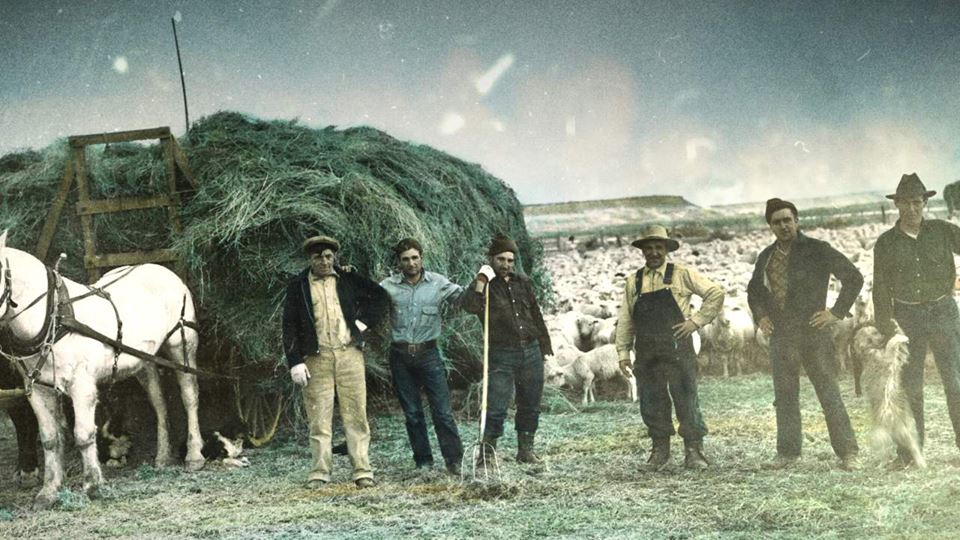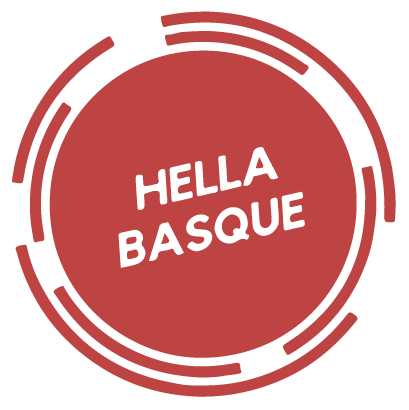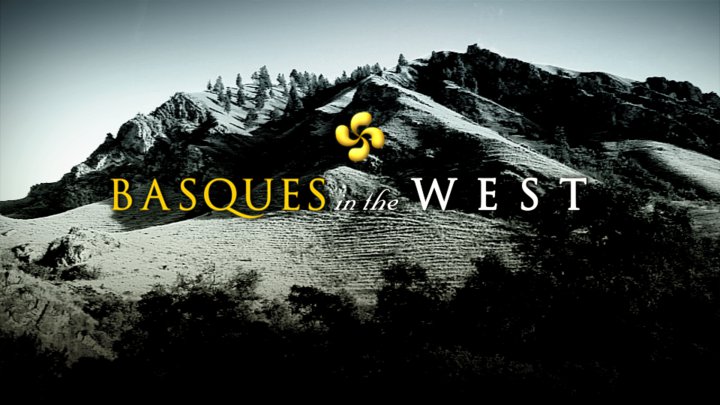This post contains affiliate links, meaning if you click through and make a purchase, I may earn a commission at no additional cost to you.
A couple of weeks ago, a new Basque documentary was uploaded to YouTube: Basques in the West. It already has more than 1,700 views!
My parents religiously watch Family Feud every night after dinner, but for one evening last week, they allowed my sister to connect her computer to the TV and put on this film. Our first family movie night in years!
And it was well worth it. The documentary features lots of interviews with Basque immigrants and their descendents around the American West, with a particular focus on Idaho.
You know I love interviews. There’s nothing better than first-hand accounts to learn about Basque immigration.
So I’m excited to share that today we have the opportunity to hear from Basques in the West’s co-director, main producer, and writer, Amaya Oxarango-Ingram.
I wanted to learn more about the documentary and how it all came together. I also especially love learning from creative people about what motivates them, and what the process is like to go from having an idea to creating an amazing piece of work that benefits the community.
What follows is an interview I conducted with Amaya about Basques in the West.

Anne-Marie: How did this project come about?
Amaya: This project was many years in the making. For my senior project in high school, I had pitched the idea of this documentary to my advisors but it was denied because I had no prior film experience and they wanted a project that they thought I could realistically bring to fruition by the end of the school year.
Cut to the end of 2008: I contacted Brent Barras because I had heard he was looking to make a multi-part docu series on culture in the Snake River Area, and he was wanting to feature some Basque characters in it.
Brent is not ethnically Basque, but he had grown up with Bascos in the Rupert/Paul area in Southern Idaho. He had the film equipment and knowledge of editing that I was looking for in order to make my dream a reality.
I was happy to help out with the interviews for Brent’s project and learn a thing or two about filmmaking in the process. But after a time it became apparent the project wasn’t going anywhere, so I decided I’d pitch him my idea that had been turned down previously.
He thought it was promising so we switched gears to make it a full-on production, and that’s how Basques in the West started. From there, the partnership grew quickly and I went from “intern” to co-director within the first couple of months of working together.
Over the course of three years, we gathered around 85 personal interviews and over 100 hours of footage.
Anne-Marie: Why did you want to make this movie?
Amaya: I wanted to make this film because I was interested in exploring and learning more about my own family’s history. I was passionate about all things Basque, and I had a desire to contribute to something bigger than myself.
Anne-Marie: What was your role in the making of this documentary?
Amaya: This project was my baby. I was the co-director, main producer and writer for the project. I was one of the film’s editors and photographers. I set up and conducted the majority of the interviews, and I was instrumental in procuring the majority of the funding for the film.
Anne-Marie: How have you been involved in Basque culture? What interests you about Basques in the West?
Amaya: Basque culture has always been a big part of my life. Growing up in rural Southern Idaho, I would often spend the weekends on my grandparents’ sheep ranch in Rupert, Idaho. I was around Basque herders (also, Mexican and Peruvian migrant workers) that worked on my family’s ranch.
From a young age, I attended many Basque festivals around Idaho and Nevada. My connection to the greater American-Basque community solidified when I attended Udaleku in the summers of 2003 in San Francisco and Boise in 2004. Through Udaleku, I met Basque kids from all over the Western United States, the Basque Country, and Argentina.
During my senior year of high school I was allowed to take on Euskera as an independent study. One of the maintenance workers at my school was actually from the town of Arrieta, and he would try and help me learn to speak in his spare time. Although he mainly spoke Arrietan Basque, not Batua like I was learning, I was always touched that he wanted to help me learn the Basque language.
When I went away to college, I joined the Oinkari Basque Dancers of Boise for a time, and I received a minor in Basque Studies from Boise State University.
I had a passion for my heritage from a young age. It was something unique that I took pride in, and I think I clung on to that identity as a way to set myself apart from others but also as a way of trying to find a place where I belonged.
Anne-Marie: How did you work with Basque communities to make this documentary?
Amaya: Since I am of Basque descent, I had many connections within the community. I just started by setting up interviews with friends and family.
I had an outline of what I wanted the film to look and feel like, but I quickly found that the true nature of documentary work is constantly evolving. It’s dependent on the interviews you get and the new leads that come from those interactions.
This snowballed into working with Basque centers and programs around the American Northwest and also working with delegates of the Autonomous Basque Government.
The film sort of took on a life of its own. Everyone I contacted was so gracious to allow me into their homes and share their personal stories. Many of them also shared a meal or a drink with us and wanted to help connect me with other people that they thought were worth talking to.
Anne-Marie: What resources did you use to contextualize the interviews for Basques in the West?
Amaya: I worked with several historians and academics from the Basque Museum and Cultural Center, the Center for Basque Studies in Reno, Nevada, the Basque Studies program at Boise State University, and several Basque historians and archeologists from the Bureau of Land Management.
But many of the historical pictures you see within the the film were donated by the various families I interviewed.
The amazing old 16mm footage you see throughout the film was donated by Ben Oneida and features his family’s home videos from the 1950’s and 1960’s. It had been sitting in a garage in Shoshone, Idaho collecting dust!
There were many other amazing finds like this one that didn’t make the final cut (only because there were so many hours of footage we had to whittle down to an hour) that I would not have had access to, because they weren’t apart of any public archives. These pictures made the film unique and special and gave context to the stories being told.
Anne-Marie: What did you learn from making this documentary?
Amaya: I learned a lot about business and film production. Above all, I learned to trust and believe in myself.
Anne-Marie: If you were to shoot the documentary again, what would you do differently?
Amaya: If I’m being honest, the perfectionist in me is not satisfied with the final product, as there is much aesthetically I would have changed and segments I felt were sloppily put together.
But the raw interviews themselves are pure gold, and I would not change a thing about those or the time I spent collecting them.
Anne-Marie: What were your hopes and goals for this film? Do you feel like you achieved them?
Amaya: Ultimately, yes. I spent three years of my life living and breathing this film. It was my passion. It was my love letter to a community that I deeply loved and cherished.
I’m glad that the documentary got to see the light of day and the stories are being celebrated, as that was my drive in creating it in the first place.
Several people I interviewed for the film have since passed on and these were their last interviews. I was able to ensure that all the raw footage interviews from the film were given to the Basque Museum and Cultural Center in Boise, Idaho as part of their digital archives. People can now go and get copies of their family’s and friends’ interviews from the project, if they wish.
I’ve had a lot of people call me over these last few years to thank me for taking the time to talk to their relatives and record their stories. For example, when Jaime Sangroniz passed away, they played his interview on a loop at the funeral. His son, James, called me afterwards to thank me for interviewing him and told me it brought his family a lot of comfort during a very sad time in their lives, and they still put it on from time to time just to hear his voice and see his smile again.
This was my drive to finish the project in the first place: to immortalize these people, their stories and their great love of all things Basque for generations to come, because they reflected my own love of the culture.
We’re all so busy living our day to day lives that we don’t often stop to think about or ask those important questions of those that came before us. We end up regretting not having those moments of connection or being able to ask that person what life was like for them until they’re gone and it’s too late.
If there’s one thing I learned during the making of this project, it’s that everyone has a story and those stories help shape my own. I wanted to share this piece of my heart with the world and have it to continue on forever.
Also, since Basques in the West, I have heard that several other projects have been launched to preserve stories within Basque-American community, because this film highlighted the need to get these people’s interviews before they pass on, especially those of first generation immigrants. This makes me happy.
Anne-Marie: Where does Basques in the West fit in with other documentaries about Basques in the US?
Amaya: This film is different from others, in that people tell their own story about how and why they continue the culture in their own unique ways. Many other documentaries that focus on the same subject matter have a voice over narrator to drive the story line.
This actually became a big point of artistic contention during the production process. My partner wanted to hire someone to narrate the film and I was adamant that we let the people tell their own story.
No one can tell a Basque’s story better than a Basque!
Also, you’ll see footage and pictures that were not part of any public records or archives prior to the making of this film. A lot of it came from the private family collections of the people that were interviewed.
We also were able to work with a talented man, Rob Ringer, who helped create original music for the film.
Fun Fact: we had him mix in sound bites from several interviews into the song played in the credits. I had him create the songs in the style of the Basque band Esne Beltza, and I think he did a great job.
All of this, to me, makes the project so special and unique.
Anne-Marie: Is there anything you’d like to add?
Amaya: I just want to take the time to thank everyone who helped and participated in this project. Without their participation and trust, this project wouldn’t have been possible.
I’d also like to make a special thank you to the Gooding Basque Association, the Seattle Euskal Etxea, the Basque Museum and Cultural Center, and the Autonomous Basque Government for their generous donations to the film (both in time and money).
I genuinely hope people enjoy watching the documentary, and I hope they feel we did justice to the stories and subject matter. My hope is that while watching it, people learn something new and gain a renewed appreciation and love for their heritage, be it Basque or something else. Aurrera!
There you have it! Thank you so much to Amaya for the generous interview.
When you have an hour, you can watch Basques in the West on YouTube.
It will be available for free online through the holidays to make for a great family movie night this Christmas.
CONTINUE READING:
- Basques Are Unique: It’s in Our Blood
- 7 Videos on Basque Sheepherders in the United States
- Go Back in Time with this Documentary on the Basque Country by Orson Welles


Facebook Comments